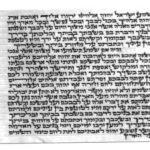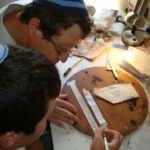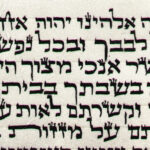-

Tefillin Gassot Medium Size – תפילין גסות בגודל בינוני
$1,196.00 Add to cart -

Regular Sized Rambam Tefillin Mehudarim
$1,680.00 Add to cart -

Medium Rambam Tefillin Mehudarim
$1,886.00 Add to cart -

Tiny Mezuzot on Klaf
$126.00 Add to cart -

שיר השירים מאוייר עם פרחים – Illuminated Shir Hashirim
$5,001.00 Add to cart -

Sofer Stam – Scribe Workshop – Tefillin
$326.00 Add to cart -

עטרה רימונים + 4 פינות – רקמה
Read more -

טלית רקמת פסים
Read more -

טלית רקמת יד מלאה
Read more -

טלית רקמת יד – עטרה + פינות רקמת יד
Read more -

Talit – Traditional Shawl Style Talit – With Techelet – Rambam 13 disks
$206.00 Add to cart -

4 מזוזות מהודרות על קלף
Read more
Inside Tefillin – Introduction to Tefillin
There are four perashiot (paragraphs written on leather parchments) inside Tefillin boxes. The same four appear both in the Tefillin that are placed on the head and the one on the arm. These perashiot speak about central concepts in Judaism.
The first perasha of “Kadesh li” discusses the freedom from slavery in Egypt. Two of the four sons from the Passover Seder are found in these paragraphs.
The second perasha of “Vehaya Ki Yevi’acha” speaks about the plague of the first born of Egypt. The death of the first born of Egypt, in addition to redeeming of out first-born sons and animals, actuate a rejection of the strengths of idolatry and magical powers. The first born of the Egyptian as well as those of other nations were priests. The sanctity of the first born within Judaism is actually a rejection of idolatrous beliefs.
The final two paragraphs that are written in the tefilin are the most famous in Judaism. They are the first two paragraphs of “Shema Yisrael”.
The portion of “Shema Yisrael” speaks about the Unity of the Blessed Creator and loving him.
The final perasha is “Vehaya im Shmo’a”. It discusses Devine Providence and heavenly reward and punishment.
There is a distinct relationship between these four perashiot. They all mention the importance of study and internalization of these subjects. Additionally, educating children in these particular subjects is mandatory. One needs to constantly teach them to his children and even more so during the Passover Seder.
A source cited in the Talmud states “A child … who can take care of tefilin, his father acquires tefilin for him.” (Tosefta Chagiga 1, Succah 42a) Parents acquire tefilin when a child becomes old enough that he can care for himself and his tefilin.
One can give this whole discussion a symbolic explanation. These concepts that we have been discussing parents teach to their children from a very young age. Parents invest a lot of effort over the course of many years to teach these concepts to their children. The father ties these central concepts that are in the tefilin onto the child’s body when he is old enough to care for himself and his things. Through this the child internalizes these subjects until they actually become part of him.
Every Bar Mitzvah boy knows the importance of the Unity of the Creator, Divine Providence, reward and punishment, the exodus from Egypt and the rejection of Avoda Zara.








